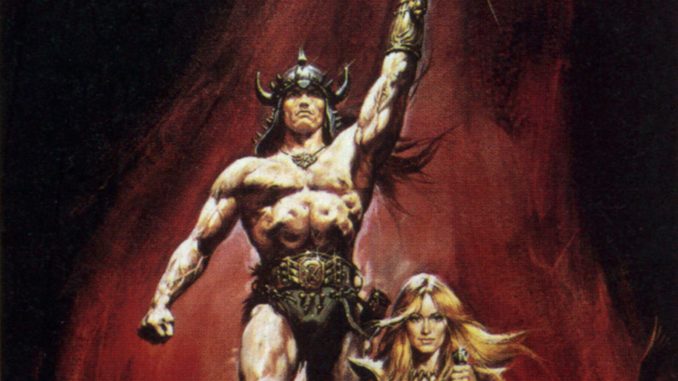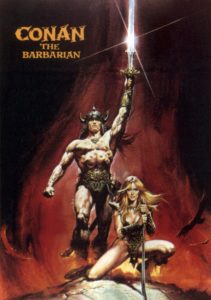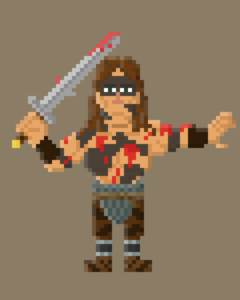
The Basics
Who hasn’t longed to revert to the baser instincts of certain 1980s adventure-action films and run around like a dim-witted, hell-bent on revenge, over-stimulated body-builder Austrian (i.e. barbarian)? Killing evil sorcerers and rescuing dainty damsels in distress from the Horrors of the Outer Forces. What about the more “classy”1 version of said barbarian in the classic 1970s comic books from Marvel; the more recent series from Dark Horse Comics; the 1990s animated show for kids; or the ’90s live action TV-series? The sources are many and varied, but none are arguably as gratifying (and chauvinist) as the original works of R.E. Howard, written in the 1930s.
That is not to say that all the stories are filled with stereotypical depictions of gender and “race”.2 Not at all. The Elephant Tower for instance is a great story, full of action, mystery and horrors. Slithering Shadows / Xuthal of the Dusk is another great story, yet here we may all react at the ridiculous portrayal of Natala the Brythunian.3 Still, the story’s focus on the alien, mysterious and other-worldly of Xuthal makes it an interesting and exciting read. I may go on and on about the various issues in the writing and portrayal of characters, but I should instead move on to what this series of articles are supposed to be about: The new Conan RPG from Modiphius Entertainment.
Just keep in mind, that there are serious issues related to eugenics and similar ideas in Howard’s writing which will, naturally, be carried over into his storyverse – a pertinent question then: is it necessary to keep it all to make it authentic to Conan?
“Civilized men are more discourteous than savages because they know they can be impolite without having their skulls split, as a general thing.”
– The Tower of the Elephant (1933)

Modiphius Entertainment has made perhaps the most Conan(!) of Conan games. Strong words, but I think you’ll agree if your experience with the storyverse in question is more than the ’80s films and some comics. I know there’s a film from 2011, I’ve watched it. It wasn’t particularly memorable, even if the aesthetics are quite true to the genre.
I assume there’s a reason they added the name Robert E. Howard to the title of this game. It is clear from the start of the core rulebook that the main focus has been on creating a game that is true to the original stories published in Weird Tales. Also, considering the lengthy list of 19 (I believe) sourcebooks planned, I would suspect the game would allow you to play your Marvel/Dark Horse Comics/Schwarzenegger/Momoa-version too but still framed by the original source material of the storyverse. I’ll admit that I haven’t played any of the Conan computer games enough to make a decent comparison.
The system, dubbed 2d20, was designed by Modiphius in collaboration with none other than Jay Little. Most readers here will be intimately familiar with his work, him being the brain behind FFGs narrative dice system and all. The 2d20 system was originally designed for the Mutant Chronicles RPG, but Modiphius has been quick about adapting it to new storyverses, having recently also released a 2d20 Star Trek RPG, and then you have the upcoming Infinity and John Carter of Mars RPGs.
Before I start the topic of this article; the core system and mechanics discussion, I would like to point out that the rulebook isn’t perfectly laid out. Due to the number of moving parts the system contains, it can involve a lot of flipping back and forth to cross-reference everything and figure out all the details. Modiphius has done an adequate job all things considered, but the book is suffering from certain reference issues and the text itself isn’t always clear and concise, making misunderstandings easy, and initial confusion likely. This may affect your reading of the book and learning the system, but it shouldn’t affect your enjoyment of the system once you have tried it (kind of like Star Wars eh?).
The core mechanics and systems are in some important ways similar to the narrative dice system of FFG, yet in many ways it differs; for instance it doesn’t use custom dice (well it does, but … later). It uses normal d20s. So, by definition, it is a so-called “binary” system. Either you succeed, or you don’t. Except that isn’t an accurate description, as you may have something positive happening on a success (Momentum and/or Doom), or something negative (Doom and/or Complication), but on a failure you may think there can be only more bad stuff happening – at least on the surface of things – but arguably you can still spend Momentum and/or generate Doom, to make something happen that is in your own favour. This way it is not just based on a roll what positive, or negative, additional effects happen. It is a conscious decision to spend Momentum (or generate Doom), that will have an effect on the narrative.
True to form this system keeps to the spirit of narration and cinematic focus that is at the core of Little’s design of the FFG system. I’d perhaps say it runs smoother, even faster. Also, the system is in some ways even more loaded in the favour of the PCs. Perhaps the clearest indication of this is that the initiative order in combat by default lets the players go first. There’s no roll or stat for initiative. The players go first. Period. Unless, of course, the GM spends one of his aforementioned Doom points from his Doom pool to seize the initiative. Yes: Doom. Doom points are akin to dark side destiny points from SWRPG, but can also be understood to be similar to threats or even despair-like effects, and more – especially looking at you, NPC Sorcerers and monstrous Horrors.
Players can generate Doom points in numerous ways: players taking too long time to discuss what to do during an action scene; reactions; adding dice to their dice pool when making a skill test; or adding additional effects to their rolls. If a player rolls a natural 20 it causes a Complication; this means dropping your weapon, damaging your weapon, going prone, or any kind of threat-like effect (or even despair-like if several Complications are rolled) that makes sense narratively – remember the Rule of Cool. However, the GM may instead opt to increase the Doom pool if no Complications seems necessary or plausible – or he just needs to increase his Doom pool. Furthermore, the GM may, of course, spend some Doom points to make that Complication even worse. Complications range in severity similar to a single threat up to several despairs in Star Wars, depending on the number of Complications rolled, and Doom points spent.
A core idea for the Doom pool is that as the heroes do their heroics they will want to spend Momentum, but producing Momentum isn’t guaranteed. This is why you generate Doom to increase the dice pool, but also to activate other effects. This means that you can easily vanquish enemies, overcome obstacles and hazards, and so on, but as you do the tension increases, the risk increases. Certain abilities or actions require the generation of Doom, like reactions. Parrying, for example, will by default produce 1 point of Doom per parry per round, increasing cumulatively. A successful parry will, of course, prevent any damage, so it is worth it. Also keep in mind that by generating Doom to roll additional dice, you may also increase the likelihood of generating your own Momentum.
The players also have their own counterpart to the Doom pool; a shared pool of Momentum. Momentum is generated individually by rolling more successes than required on a skill test. Players can spend all or some of the generated Momentum on the skill test just made in similar ways to advantages in SWRPG; gaining more details from observation tests, lore tests and improved results when crafting, regain lost Vigor or Resolve, called shots, damage re-rolls, and more. Any remaining Momentum is lost or added to the group’s shared Momentum pool. Now all the players may use these remaining Momentum points for their skill tests, either before and/or after rolling.
The differences between the Doom and Momentum pools are that players may add Doom points to the GMs pool or spend their own Momentum for their own gain, the GM, however, may only spend Doom points – he has no access to the Momentum pool. Also, while the GM may have any number of Doom points in his pool, the players may never have more than 6 in their shared pool at any given time – and it decreases automatically over time. For players, Doom points and Momentum can be spent interchangeably. The GM also, technically, produces Momentum when attacking with non-allied and/or enemy NPCs, any remaining Momentum, however, is converted into Doom points at a 1-for-1 ratio. Allied NPCs may only use Momentum from the shared pool is the players allow it, but these NPCs may not contribute to the shared Momentum pool.
“Conan sensed their uncertainty and grinned mirthlessly and ferociously. “Who dies first?”
– The Phoenix on the Sword (1932)

A skill test in Conan 2d20 requires you to roll a number of d20 dice, normally 2, but sometimes more up to a maximum of 5 (costing Doom and/or Momentum) and sometimes only 1. To succeed you are required to roll equal to or under a target number that equals your Attribute + Skill Expertise. You get 1 success per die succeeding in reaching that target number. For instance, Conan the Mercenary has a Brawn of 13 and Athletics Skill Expertise of 3 (and Skill Focus of 3). This means Conan needs to roll 16 or lower to get successes on Athletics checks. Furthermore, skills have an additional aspect called Focus. Focus, just like Expertise, ranges from 0 to 5 ranks and is bought separately during play, but simultaneously during character creation. Focus is not added to your target number, instead it’s a separate target number on its own. If, when you make a skill test, you roll equal to or lower than your Focus you produce 2 successes instead 1. So, if Conan is making an Athletics test rolling 2d20 gets a result of 2 and 9, he would’ve produced 3 successes, the 2 being lower than his Skill Focus produces 2 successes, while the 9 produces 1.
Difficulty ratings in Conan requires you to acquire a number of successes equal to the difficulty rating. For instance, an average difficulty is D1, and requires 1 success. An Epic check is D5 and requires 5 successes. Depending on the difficulty of the check, Conan’s result from above could be anywhere between failure, 0 and 3 Momentum to spend. Yes, some skill tests have a difficulty rating of 0, where the roll is only made (if it is made) to see how many Momentum the character can produce, and if a Complication happens. Difficulties can of course be adjusted up or down to suit the environment and conditions relevant to the skill test, like lighting situation, slippery floors, weather and more.
Fortune points are another moving part for the players. Spending one Fortune point allows the players to fully restore Vigor (physical endurance) or Resolve (mental endurance). Alternately, you can add a d20 to your check that is not rolled, but counts as an automatic 1, so a potential auto-success on a skill test. It can also do a lot more, but I won’t get into further detail. Suffice to say, Fortune points are very useful and there’s a limit to how many you can have at any given time (default is 5, but this may be decreased during character creation and through play; hello sorcery). There also a talent tree related to Fortune points, letting you spend them for additional effects.
Hopefully this summary of the core mechanics provides a basic overview and some insight. There is of course more to this system, other moving parts and aspects, some of which I’ll get into in future articles. Next I’ll cover character creation, moving on to combat and then sorcery and other qualities of the game and my experience with game-play.
1 Really?! Did I just call Conan classy?!
2 At the time of the writing of Conan, ideas about “race” based in eugenics and similar pseudo-sciences were rampant.
3 Of course not all ridiculous, but mostly ridiculous. I guess you could argue she’s the one with the most sense and is merely a victim of Conan’s stupidity. You could do that. It wouldn’t be wrong, but it wouldn’t be correct either.
Lagre
Lagre

You used my single favorite Conan quote ever.